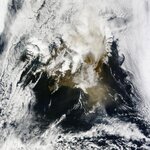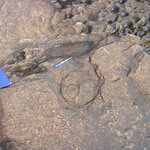Geology

If you're anything more than an infrequent stumbler to Science 2.0, then you will probably have noticed - if not, read - Helen's article on geomagnetic polarity reversals, which until recently has been floating in the top articles list.
Whilst it's a gallant attempt to understand the ins and outs of an incredibly complex and poorly understood process, there are a number of misconceptions that I thought would be a good idea to clear up. It's clearly a topic of great interest, because there are over 400 comments on the article.
Before going into these misconceptions, though, let's start with…
Most people know that we have tried to judge what may happen during global warming by creating gigantic models of the Earth system, and see how it responds to forcing from different factors.
Another way that we approach the problem, is, (in my opinion) a much more interesting line of research, and that is looking in the geological record to see how the Earth responded in the past to global warming events, and to use these to inform us about what may happen now.
One of the most famous global warming events in the geological record is the PETM, which took place at 55.9 Ma. This caused the Earth…
Most people know that we have tried to judge what may happen during global warming by creating gigantic models of the Earth system, and see how it responds to forcing from different factors.
Another way that we approach the problem, is, (in my opinion) a much more interesting line of research, and that is looking in the geological record to see how the Earth responded in the past to global warming events, and to use these as analogues for what may happen now.
One of the most famous global warming events in the geological record is the PETM, which took place 55.9 Ma. This caused the Earth's…

Contrary to what you might think by the name, Greenland is rather frigid and Iceland is often quite nice. Nice for Vikings, anyway. But for a time Greenland became so miserable even Scandinavians had enough.
Scientists have examined 5,600 years of climate history from two lakes in Kangerlussuaq, near the Norse "Western Settlement." Unlike ice cores taken from the Greenland ice sheet hundreds of miles inland, the new lake core measurements reflect air temperatures where Vikings lived in the 14th and 15 centuries, as well as those experienced by the Saqqaq and the Dorset,…

In 2010 volcanic ash from Eyjafjallajökull clouded Europe for days. It opened up a discussion about how science is used in risk management. Europe had just finished its first volcanic ash crisis exercise validating changes and improvements to the volcanic ash contingency plan and procedures, when a new eruption on Iceland, the Grímsvötn volcano beneath the vast Vatnajökull glacier, threatened air travel and ultimately our economy once more just over a year after Eyjafjallajökull.
Iceland covered with snow. Credit: NASA
Iceland is an exotic island. It is exotic in at least two ways; its remote…

Grímsvötn Ash Plume
Grímsvötn, an ice-capped volcano in the south of Iceland is currently erupting. The ice cap is quite extensive and thick, so unless there are unknown sub-surface fissures, extensive local flooding is unlikely to result from the eruption.
The volcano is likely to melt only the ice immediately over and adjacent to the caldera. Melt water intrusion into magma can increase the production of tephra, as happened with last year's eruption of Eyjafjallajökull. However, the ice cap of Grímsvötn is so thick that the erupting volcano will probably do no more than…

The Earth's inner core is a ball of solid iron about the size of the Moon. This iron core is surrounded by a dynamic outer core of a liquid iron-nickel alloy - along with other, lighter elements - a highly viscous mantle and a solid crust that forms the surface where we live.
That inner core is simultaneously melting and freezing due to circulation of heat in the overlying rocky mantle, according to new research . Over billions of years, the Earth has cooled from the inside out causing the molten iron core to partly freeze and solidify. The inner core has subsequently been growing at…

The first large-scale picture of the electrical conductivity of the underground molten rock that feeds the Yellowstone supervolcano suggests that the plume beneath the volcanically active area, known for geysers and hot springs, is even bigger than it appeared in images made with earthquake waves.
In the past 2 million years, three eruptions at Yellowstone have spewed enough volcanic ash to cover half of North America. The new study doesn't speculate about the chances of another cataclysmic caldera eruption at Yellowstone but it gives new perspective on the deep reservoir of fiery…

For 20 years, some seismologists in Japan, such as Katsuhiko Ishibashi, now professor emeritus at Kobe University, have warned of the seismic and tsunami hazards to the safety of nuclear power plants.
Yet in the immediate aftermath of the magnitude-9.1 earthquake that struck Tohoku on 11 March, pundits could be found on many Japanese TV stations saying that it was “unforeseeable”.
That's because the 'foreseen' earthquakes were using flawed methodology, argues Robert J. Geller in a Nature Comment piece. Geller is in the Department of Earth and Planetary Science, Graduate…

These are fulgerites,
Now, without googling (!) can you tell what they are?
You can find several fulgerites at Corrie on the Isle of Arran (I've heard that there were something like 5, but I could only find 2).
You might think that they look biological, but in actual fact they are found in wind-blown desert sandstones; not a site condusive to preserving fossils.
The Corrie foreshore; apologies for the poor quality photos. In the distance you can just see Holy Island. Geologists among you, look for the large aeolian crossed-beds!
A clue: if you were take a section through, you would see…